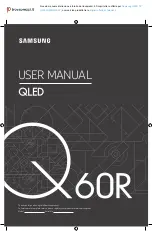
Service manual CP 385 / CP785
- 39 -
5-3 Source switching
The TDA936x has only one external video input, the external video switching circuit made with Q504,
Q505, Q507, Q508 and Q509 allows 2 external video signal inputs. The switching command can be
either the SCART1 slow switching pin 8 or the
µ
-Controller pin 8 when the software takes control of
the video source. The
µ
-Controller pin 8 is automatically configured by the controlling software ( See
table below ). This pin is also capable of detecting the 3 Status ( 0, 1A, 1B ) described in SCART
specifications for automatic format switching ( chassis CP785 only ).
TV mode
µ
-Controller pin 8 Status
Level
RF auto
Input - High Impedance
< 1V
RF Forced
Input - High Impedance
not defined
AV 1 Auto 4:3
Input - High Impedance
> 2.0 V
AV 1 Auto 16:9
Input - High Impedance
1 V < x < 2.0 V
AV 1 forced
Output - Push Pull
Max. 3.3V
AV 2
Output - Push Pull
< 0.2 V
SVHS
Output - Push Pull
< 0.2 V
The controlling software via I2C bus selects the signal source :
- Video signal from tuner ( Pin 40 ).
- External video ( SCART 1 or 2 ) depending on Q508 base level.
- External SVHS from SCART 2.
The sound source switching is done in the MSP3415D ( I601 ), by the
µ
-Controller via I2C bus.
Fast R, G, B insertion : The external R, G, B insertion needs a fast switching and cannot be controlled
by the software ( instruction cycle of 1
µ
sec ). The fast switching pin 16 of SCART 1 is directly
connected to the TV processor pin 45 ( Fast blanking input ). The display is synchronised with the
selected video source, i.e. to get stable R, G, B inserted signal they must be synchronised with the
selected video source. The controlling software only enable or disable ( AV2, SVHS, or Forced RF
source selected ) fast blanking.
5-4
µ
-Controller I/O pin configuration and function
The I/O pins of the
µ
-Controller can be configured in many way. All port functions can be individually
programmed by use of the SFR registers.
Each I/O port pin can be individually programmed in these configurations :
Open drain
In this mode, the port can function as in and output. It requires an external pull-up resistor. The
maximum allowable supply voltage for this pull up resistor is +5V.
So in this mode it is possible to interface a 5 Volt environment like I2C while the
µ
-Controller has a 3.3
Volt supply.
Push-Pull
The push pull mode can be used for output only. Both sinking and sourcing is active, which leads to
sleep slopes. The levels are 0 and Vddp, the supply voltage 3.3Volts.
Summary of Contents for DTA-20 T1
Page 17: ...Service manual CP 385 CP785 16...
Page 21: ...Service manual CP 385 CP785 20...
Page 34: ...Service manual CP 385 CP785 33 5 Circuit description 5 1 Block diagram...
Page 39: ...Service manual CP 385 CP785 38 Chassis block diagram IF...
Page 43: ...Service manual CP 385 CP785 42 Sound signal flow diagram...
Page 70: ...69 Service Manual cp 385 cp 785 7 Exploded View 7 1 DTA 20T1...
Page 73: ...72 7 4 DTA 20T8 Service Manual cp 385 cp 785...
Page 74: ...73 7 5 DTA 21T1 Service Manual cp 385 cp 785...
Page 76: ...75 7 7 DTA 21T5 Service Manual cp 385 cp 785...
Page 77: ...76 7 8 DTA 21T9 Service Manual cp 385 cp 785...
Page 79: ...78 Service Manual cp 385 cp 785 7 10 DTE 25G6...
Page 80: ...79 Service Manual cp 385 cp 785 7 11 DTE 25G7...
Page 82: ...81 7 13 DTE 28G6 Service Manual cp 385 cp 785...
Page 90: ......
Page 91: ......
















































